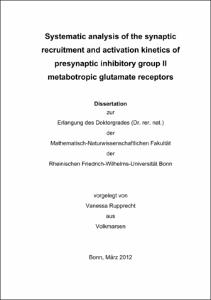Systematic analysis of the synaptic recruitment and activation kinetics of presynaptic inhibitory group II metabotropic glutamate receptors

Systematic analysis of the synaptic recruitment and activation kinetics of presynaptic inhibitory group II metabotropic glutamate receptors

| dc.contributor.advisor | Dietrich, Dirk | |
| dc.contributor.author | Rupprecht, Vanessa | |
| dc.date.accessioned | 2020-04-17T22:51:39Z | |
| dc.date.available | 2020-04-17T22:51:39Z | |
| dc.date.issued | 22.08.2012 | |
| dc.identifier.uri | https://hdl.handle.net/20.500.11811/5327 | |
| dc.description.abstract | Pharmacological activation of presynaptic inhibitory group II mGluRs potently modulates excitatory synaptic transmission throughout the brain. However, little is known about the physiological conditions under which these receptors are activated by synaptically released glutamate. To routinely test for activation by action potential driven glutamate release, we applied a conditioning burst (7 stim at 100 Hz) to presynaptic axons in the presence (12.6 ± 1.3%, n=32; 100µM, 17 ± 2.4%, n=13) or absence (5.5 ± 0.9%, n=8) of the glutamate transporter blocker DL-TBOA (40uM) and assessed the resulting receptor activation with the mGluR antagonist LY341495 (3µM). The inhibition reached its maximum with 100µM DL-TBOA. However, strong glutamate transporter blockade did not only facilitate synaptic group II mGluR activation, it caused additionally a stimulation independent activation by accumulated, spontaneously released glutamate alone (19.9 ± 4.5%, n=5), which required the use of a lower DL-TBOA concentration (40µM) to keep mGluR activation facilitated but reduce spontaneous, stimulation independent mGluR effects to an insignificant degree (6.5 ± 1.7%, n=5). Examining the mGluR mediated inhibition on the test fEPSP at different post burst intervals (PBI) revealed a peak depression at 0.2 ms PBI (13 ± 1%, n=34) which was still detectable even after 0.8 s PBI (8 ± 1%, n=7). The maximal inhibition of fEPSPs amounted to 30 ± 6% when applying 100 stim at 100 Hz using 0.2 sec PBI (n=9). Testing different frequencies within the conditioning burst revealed a maximum group II mGluR activation at 200Hz (23 ± 3%, n=10). To investigate the kinetics of group II mGluRs in more detail, we performed glutamate uncaging together with presynaptic Ca2+ imaging and assessed mGluR activation via uncaging-induced inhibition of presynaptic Ca2+ transients. We designed a laser stimulation protocol which yielded nearly rectangular steps in the extracellular glutamate concentration. Testing the activation time revealed a maximum depressed Ca2+ signal amplitude after 450ms (16.7 ± 2.5%, n=3). An upper estimation for the deactivation showed an inhibition of Ca2+ entry upon glutamate uncaging slightly dropping to 65.6 ± 4.2% (n=5) 600 ms after uncaging and was still detectable after 2000 ms (16.5 ± 4.4%, n=3). When estimating the lower limit, the inhibition was gone after a 409 ms post-uncaging interval (1.7 ± 0.4%, n=6) (tau= 150ms). Summarizing fEPSP and imaging data, group II mGluR activation kinetics was shown to be relatively fast (fEPSP rec.: tau= 40 ± 20ms; Ca2+ imag.: tau= 150 ± 30ms), whereas the deactivation kinetics were indicated to be slower (fEPSP rec.: 840 ± 230ms; Ca2+ imag.: between 150 ± 110ms and 1870 ± 60ms). These data support the idea that the functional significance of mGluRs as presynaptic autoreceptors is not the degree of inhibition, but rather a long duration of inhibition of glutamatergic transmission and that this function is due to intrinsically slow receptor kinetics. | |
| dc.language.iso | eng | |
| dc.rights | In Copyright | |
| dc.rights.uri | http://rightsstatements.org/vocab/InC/1.0/ | |
| dc.subject | presynaptic group II mGluRs | |
| dc.subject | synaptic activation | |
| dc.subject | presynaptic Ca2+ imaging | |
| dc.subject | glutamate uncaging | |
| dc.subject | slow receptor kinetics | |
| dc.subject.ddc | 500 Naturwissenschaften | |
| dc.title | Systematic analysis of the synaptic recruitment and activation kinetics of presynaptic inhibitory group II metabotropic glutamate receptors | |
| dc.type | Dissertation oder Habilitation | |
| dc.publisher.name | Universitäts- und Landesbibliothek Bonn | |
| dc.publisher.location | Bonn | |
| dc.rights.accessRights | openAccess | |
| dc.identifier.urn | https://nbn-resolving.org/urn:nbn:de:hbz:5n-28941 | |
| ulbbn.pubtype | Erstveröffentlichung | |
| ulbbnediss.affiliation.name | Rheinische Friedrich-Wilhelms-Universität Bonn | |
| ulbbnediss.affiliation.location | Bonn | |
| ulbbnediss.thesis.level | Dissertation | |
| ulbbnediss.dissID | 2894 | |
| ulbbnediss.date.accepted | 17.08.2012 | |
| ulbbnediss.fakultaet | Mathematisch-Naturwissenschaftliche Fakultät | |
| dc.contributor.coReferee | von der Emde, Gerhard |
Dateien zu dieser Ressource
Das Dokument erscheint in:
-
E-Dissertationen (4118)




